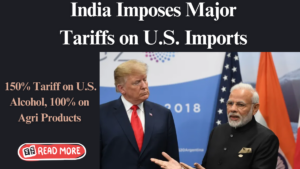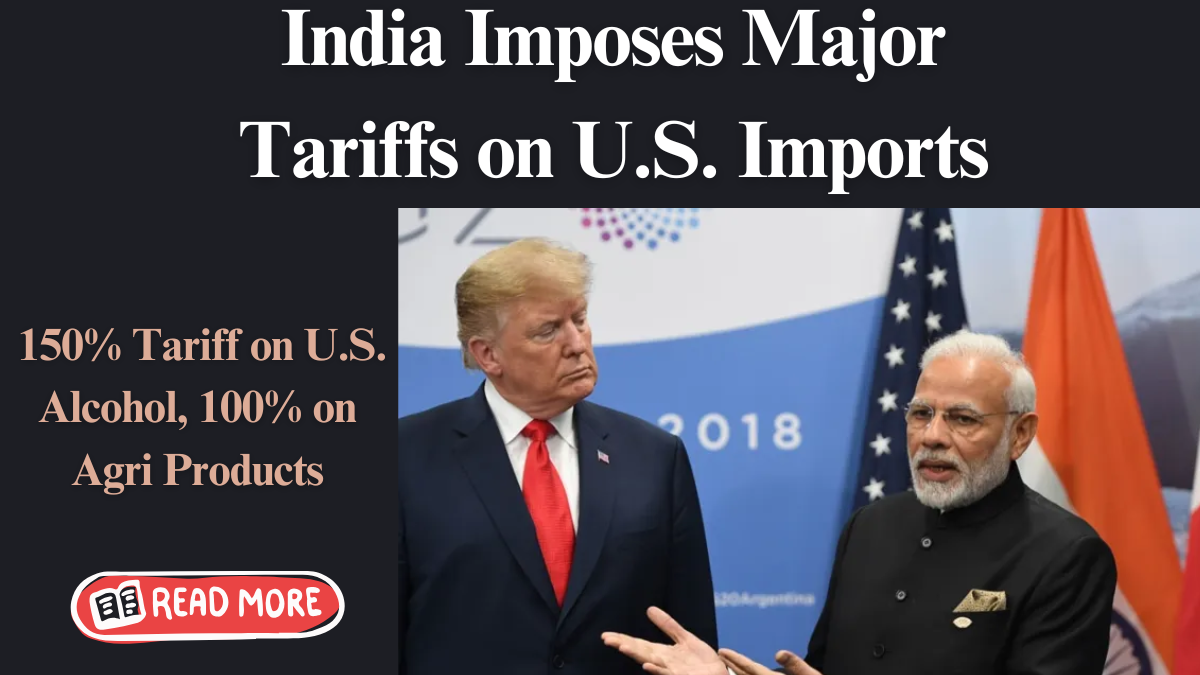India has made a significant move in its trade relations with the United States by imposing high tariffs on American alcohol and agricultural products. According to the White House, India has levied a 150% tariff on American alcoholic beverages and a 100% tariff on various agricultural goods. This decision comes as a response to ongoing trade tensions and is likely to have significant consequences for both countries’ economies.

What Are the New Tariffs?
The new tariffs, set to take effect immediately, target specific U.S. exports, primarily alcohol and agricultural products. The 150% tariff on American alcoholic beverages includes wines, spirits, and other liquor products, making them much more expensive in the Indian market. Similarly, agricultural products like fruits, nuts, and grains will be subject to a 100% tariff, further increasing the cost of these goods for Indian consumers.
This move by India is seen as a response to the United States’ actions regarding trade policies and tariffs on certain Indian goods, particularly steel and aluminum.
Why Did India Impose These Tariffs?
India’s decision to impose these tariffs is rooted in trade disagreements and the desire to protect domestic industries. In recent years, trade tensions have escalated between the two countries, with both sides implementing tariffs on each other’s products. India has sought to retaliate against the U.S. tariffs on Indian steel and aluminum, which had a significant impact on Indian manufacturers.
India’s government has stated that these tariffs will help safeguard local industries, particularly those in agriculture and alcohol production, which may struggle to compete with cheap imports. Additionally, India wants to protect its domestic agricultural sector, which provides livelihoods for millions of people.
The Potential Impact on the U.S.-India Trade Relationship
This move is expected to strain the trade relationship between India and the U.S., two of the world’s largest economies. While these tariffs may provide short-term protection for India’s local industries, the long-term effects could be more complicated. The United States is likely to respond with its own tariffs or trade restrictions, which could lead to further trade imbalances.
The U.S. exports billions of dollars’ worth of goods to India, including alcohol, agricultural products, and technology. With these new tariffs in place, U.S. businesses could find it harder to enter the Indian market, which could lead to losses in revenue and job opportunities. Conversely, the Indian government may face pressure from domestic businesses to reduce or lift these tariffs if they lead to higher prices for consumers.
Impact on Consumers in India
For Indian consumers, the increased tariffs are likely to result in higher prices for imported alcoholic beverages and agricultural goods. Products that were once more affordable due to cheaper imports may now become significantly more expensive, which could lead to reduced consumption and changes in buying patterns.
The price increase in imported alcohol, in particular, could impact the hospitality and retail industries, as it will become more costly to stock these items. As a result, businesses in India that rely on American alcohol imports may be forced to pass on the additional costs to consumers, potentially leading to decreased sales.
Potential Consequences for Global Trade
India’s tariff increase is not an isolated case, as trade protectionism has become more common worldwide. Many countries are looking to safeguard their domestic industries, especially in the wake of the global economic slowdown and the challenges posed by the COVID-19 pandemic. While tariffs can provide temporary relief for local producers, they can also disrupt global supply chains and increase tensions between trading partners.
For global trade, this move by India signals a shift towards more protectionist policies. Countries that rely on trade with India, especially the U.S., may need to adapt to these new tariffs, which could lead to a reevaluation of their trade strategies.
Moving Forward: What’s Next for U.S.-India Trade?
The imposition of tariffs by India on American goods will likely lead to more negotiations between the U.S. and India. Both nations will have to work together to find a resolution that benefits their economies without further escalating trade tensions. Trade talks, likely focusing on mutual concessions, could help both sides find common ground and ease the impact of the tariffs.
At the same time, the global trade community will be watching closely to see if this is part of a broader trend toward protectionism or if it remains an isolated event driven by specific trade disputes.
Conclusion
India’s decision to impose a 150% tariff on American alcohol and a 100% tariff on agricultural products is a significant step in the ongoing trade tensions between the two countries. While the move aims to protect local industries, it is likely to have far-reaching consequences for both India and the U.S. in terms of economic growth, consumer prices, and global trade relations. As both countries navigate this new phase in their trade relationship, it will be interesting to see how the situation develops and whether further actions will be taken to address the concerns on both sides.
FAQ
1. Why has India imposed these new tariffs on U.S. goods?
India imposed these tariffs as a response to trade tensions with the United States, particularly regarding U.S. tariffs on Indian steel and aluminum. The aim is to protect India’s domestic industries, including alcohol and agriculture, from cheap imports.
2. How will these tariffs affect Indian consumers?
The increased tariffs will likely lead to higher prices for imported alcohol and agricultural products, making them more expensive for consumers in India.
3. What products are affected by the new tariffs?
The new tariffs primarily target American alcoholic beverages, such as wines and spirits, and agricultural products, including fruits, nuts, and grains.
4. What impact will these tariffs have on U.S. businesses?
U.S. businesses exporting alcohol and agricultural products to India may face reduced market access and higher costs, which could lead to decreased revenue and potential job losses.
5. Will this affect global trade?
Yes, this move may signal a broader trend toward protectionism and could disrupt global supply chains, affecting other countries that rely on trade with India and the U.S.
Click here to learn more.
Pari is a passionate writer known for captivating stories that blend imagination and reality. Inspired by travel, history, and everyday moments, Pari crafts narratives that resonate deeply with readers.
